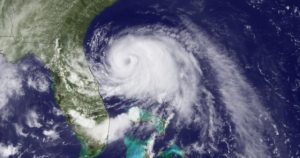Under the Weather

With hurricane season upon us, we might learn something from the models that meteorologists offer when a large sea-storm heads for land. Something about Shemini Atzeres.
The maps created as a storm approaches often include colored lines indicating the projected paths of the hurricane as predicted by different models, each based on its own sets of data and methodology. The combined yield looks suspiciously like, though not as appetizing as, spaghetti. Only one model (if even that) will end up “winning” the prediction contest. And, as likely as not, the next storm around, a different model, based on different calculations, will emerge as the retroactively prophetic one.
“Cause and effect” is a basic principle of modern science. By observing what seems to make happenings happen, we can predict, at least theoretically and if in possession of sufficient information, almost anything.
Weather forecasting, despite mountains of data gleaned from satellites, weather stations and previous storms, cannot even generally predict a storm’s movement or intensity beyond a day or two.
That might be attributed to the sheer amount of information needed to make a weather forecast, and the complexity of combining all the necessary elements. There is what has whimsically been called the “Butterfly Effect” (and more soberly, “sensitive dependence on initial conditions”) – the idea that even something like the flapping of a butterfly’s wings in Asia might have an effect on the course of a storm in the Carolinas.
But something deeper and more subtle is at work, too. An accepted idea in modern physics, Heisenberg’s Uncertainty Principle, has it that at the most fundamental strata of physical matter, there is a limit to what can be known. The more precisely the position of a particle is determined, the less precisely its momentum can be known, and vice versa. So there is an inherent element of unknowableness (well, there should be such a word) in the matter comprising the universe.
What we call nature, in other words, isn’t truly predictable, or even “natural.” Nature is just the word we use to describe miracles we’ve come to take for granted.
Consider the weird world Rav Eliyahu Eliezer Dessler, zt”l, asks us to imagine, where the deceased routinely arise from their graves rejuvenated, but grain and vegetation do not exist.
In the thought experiment, a man appears holding a seed, something never seen before in this strange place. He loosens some soil and places the tiny kernel into the ground. The locals wonder at the oddity –why is he burying a pebble? – and are astonished when, several days later, a green sprout pierces the soil where the seed had been consigned. When it develops into a full-fledged plant, even – most shocking of all – bearing seeds of its own, the onlookers are flabbergasted.
Techiyas hameisim will be similarly amazing to those who will witness it, observes Rav Dessler. What is more, in our world, a seed’s growth is itself no less a miracle, willed from above. The numerical equivalent of the word “hateva,” – “the [realm of] nature” –sefarim hakedoshim note, equals Elokim.
Miracles we haven’t previously experienced impress us. Miracles we live with daily are harder to appreciate. “If the stars should appear one night in a thousand years,” wrote the poet R. W. Emerson, “how would men believe and adore…!”
Or as famed physicist Paul Davies wrote a few years back, “The very notion of physical law is a theological one.”
The miraculous, in other words, is ubiquitous, even if the phantom of predictability lessens our appreciation of it. Weather, though, with its fickleness, reminds us of what we easily forget: that uncertainty is the real rule, underlying even the very building blocks of matter.
In fact, the Hebrew word for “rain,” geshem, means “physical matter” as well.
There is a human entity, too, that eludes predictability. Empires and nations rise and fall, never to rise again. Populations are exiled from their lands and never return. Those are “natural” rules of history. You know the exception.
The number eight, the Maharal teaches, represents the miraculous, what lies beyond what we call nature. Klal Yisrael, the Midrash says, is the partner of Shabbos, and hence, in a sense, the “eighth day.”
In the time of the Beis Hamikdash, on Shemini Atzeres, the “Eighth Day Festival,” after the Sukkos offerings of 70 parim representing the nations of the world, a single par, representing a singular nation, was offered.
That, on the day when we remind ourselves that there really isn’t any independent entity called “nature” – focusing on the wonder that is Klal Yisrael, and, in Tefillas Geshem, on the wonder that is rain.
© 2016 Hamodia



Recent Comments